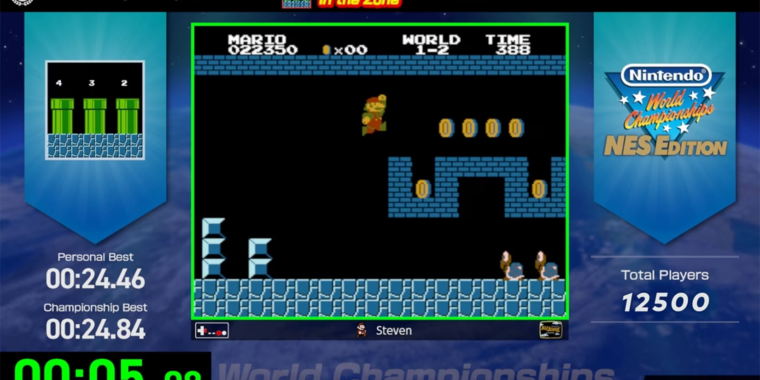Mario again and again… and again… and again.”/>
If you’ve ever seen a video game that broke speed records or watched a Games Done Quick marathon, you might have fantasized that you, too, could achieve decent times in your old favorite games. Sure, it would probably take a little practice, but what these speedrunners are doing doesn’t seem like much of a stretch. How difficultIsn’t that right? How hard can it be to press a few buttons at just the right time for a few minutes?
After spending a few weeks with Nintendo World Championships: NES EditionI don’t think that way anymore. The bite-sized snippets of classic Nintendo games shown in the game highlight the level of precision needed to achieve perfection in speedrunning even for a few minutes, not to mention the tedium of practicing the same in-game moves dozens of times to develop the necessary muscle memory. In the process, I gained a newfound respect for the skill displayed by the best speedrunners, and found a new way to experience some classic NES games that I felt like I knew inside and out.
I have to go fast
While Nintendo World Championship While Speedrun is named after a series of competitions dating back to 1990, its inspiration is much more directly derived from the more recent rise of the online speedrun community. As such, the game’s main single-player mode is called “Speedrun,” and sees players trying to achieve the fastest times in 150 mini-challenges spread across 13 different Nintendo-developed NES titles.

Nintendo
The first of these many unlockable challenges seems almost insultingly easy at first glance: collect the first Super Mushroom in Super Mario Bros. or pick up the sword in The legend of ZeldaFor example, when you first dive in, you might be more than a little baffled to find that you’re inundated with in-game rewards for spending just a few seconds completing such basic tasks.
But then you see how long it took you to complete that challenge (shown on the screen in huge numbers) along with an even bigger letter grade. The “A” you got for collecting that mushroom might seem pretty good at first, but you know you could do better if you didn’t miss the item box on your first few jumps. So you quickly restart the challenge (and take a deep breath during a helpful three-second countdown) and shave off a half-second on your second attempt, allowing you to get an “A+” for your efforts.
If you’re a certain type of player, you might say, “Okay, that’s enough,” rather than repeat this cycle over again (if so, I’d say this game isn’t for you). But if you’re a different type of player, the mere knowledge that could Achieving an S rank with a combination of strategy and execution will propel you through minutes of repeated attempts, seeking to optimize the perfect seconds of button presses.
The fact that Nintendo doesn’t reveal specific cutoff times for the different letter grades is both frustrating and subtly encouraging. There were plenty of challenges where I felt like I played my best and only received an “A++” grade alongside my new best time. The mere existence of the S grade often inspired me to redouble my efforts and look for new ways to shave even more time off my personal best.
